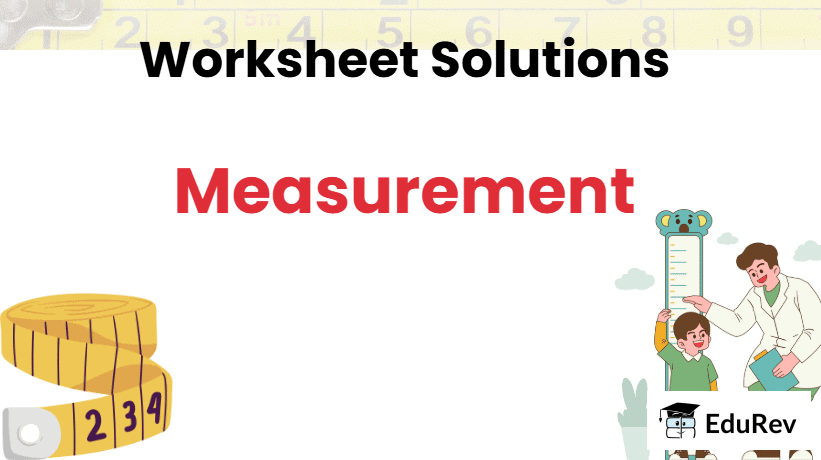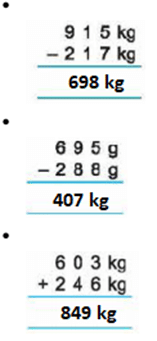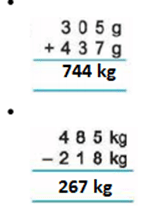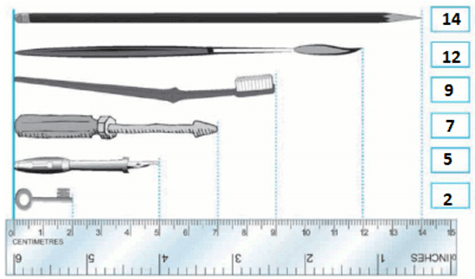Class 3 Maths - Measurement - CBSE Worksheets Solutions

Q1: Cross (X) the containers which have capacity of less than a litre:

Q2: A 1 l bottle is half full. How many millilitres are there in the bottle?
Ans: A 1L bottle is half full
1 L = 1000 ml
Half of 1 L = 1000/2 = 500 ml
Q3: A Jug holds 350 ml and another jug holds 650 ml. How many total litres do the jugs hold?
Ans: One Jug holds = 350 ml and
Another jug holds = 650 ml.
Both jugs hold = 350 ml + 650 ml = 1000ml = 1L
Q4: How many 250 ml cups are needed to half fill a 2 l bottle?
Ans: 8 cups are needed to fill 2 litre bottles.
Q5: Add:
a) 370 l + 195 l = 565 L
b) 126 l + 478 l = 604 L
c) 30 ml + 90 ml = 120 ml
Q6: Subtract:
a) 819 l - 406 l = 413 L
b) 179 l - 86 l = 93 L
c) 395 ml - 274 ml = 121 ml
Q7: 2 l = 2000 ml.
Q8: How many 500 ml mugs are needed to fill a 2 l bottle? ______
Ans: 4 mugs of 5ml are needed to fill a 2 l bottle
Q9: Fill in the blanks:
a) Weight of the mobile phone is 50 g.
b) Weight of pineapples is 2 kg.
c) Weight of apples is 1 kg.
Q10: Answer the following:
a) What should be added to 7 kilograms to make it 22 kilograms?
Ans: 22 - 7 = 15 kg
b) Weight of Deepak is 52 kg and weight of Sakshi is 37 kg. Who is heavier and by how much?
Ans: Weight of Deepak = 52 kg
weight of Sakshi = 37 kg.
Deepak is heavier by 15 kg
Q11: Add or subtract:


Q12: Observe and fill in the blanks:
a) Weight of the cup is 100 g.
b) Weight of the book is 200 g.
c) Weight of the pears 1 kg.
Q13: Write down the lengths of the objects in the box:

Q14: Measure the lengths of the line segments and write their lengths in the blank space:

The length of the line segment EF is 8 cm.
The length of the line segment AB is 6 cm.
The length of AB = 5.5 cm.
The length of BC = 4 cm.
The length of CD = 5 cm.
The length of AB + BC + CD = 14.5 cm.
Q15: Convert the following lengths into centimetres:
a) 8 m 21 cm
1m = 100 cm
800cm + 21 cm = 821cm
b) 21 m 6 cm
1m = 100cm
2100 + 6 = 2106 cm
c) 105 m 92 cm
1m = 100cm
10500 + 92 = 10592 cm
Q16: Convert the following lengths into centimetres:
a) 102 m = 10200 cm
b) 46 m = 4600 cm
c) 14 m = 1400 cm
d) 4 m = 400 cm
e) 214 m = 21400 cm
Q17: Add each of the following:

Q18: Arrange in columns and add:
Q19: Subtract each of the following:

Q20: A goods train is 232 m 55 cm long and a passenger train is 109 m 25 cm long. Which train is longer and by how much?
Ans: A goods train = 232 m 55 cm long
A passenger train = 109 m 25 cm long
Goods train is longer by 123m 30cm.
Q21: Ravi's brother bought 217 m 65 cm electric wire. He used 76 m 20 cm wire for electric fitting. How much of the wire was left with him?
Ans: Ravi's brother bought electric wire = 217 m 65 cm
He used for fitting = 76 m 20 cm wire for electric
Wire left = 217m 65 cm - 76m 20 cm = 141m 45cm.
Q22: Kirti is 1 m 48 cm tall. Her sister is 17 cm taller than her. Find the height of Kirti's sister.
Ans: Kirti is 1 m 48 cm tall.
Her sister is 17 cm taller
Height of Kirti’s sister = 1m 48 cm - 17 cm = 1m 31m.
|
20 videos|188 docs|25 tests
|
FAQs on Class 3 Maths - Measurement - CBSE Worksheets Solutions
| 1. What is measurement? |  |
| 2. What are the different types of measurements? |  |
| 3. How do we measure length? |  |
| 4. What are the common units of weight? |  |
| 5. How can we measure capacity? |  |



















